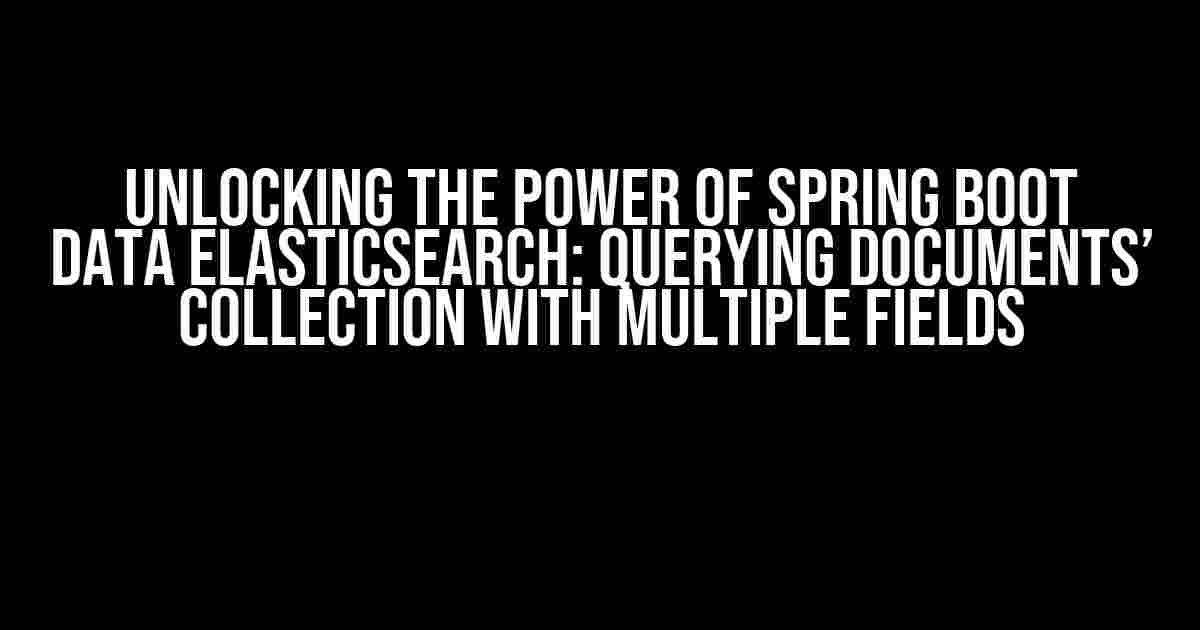Are you tired of tediously searching through vast amounts of data, only to find that your queries are slow and inefficient? Do you wish you had a more efficient way to query your Elasticsearch documents’ collection, taking into account multiple fields at once? Look no further! In this comprehensive guide, we’ll explore the wonders of Spring Boot Data Elasticsearch, and how to harness its power to query documents with multiple fields.
Why Spring Boot Data Elasticsearch?
Before we dive into the nitty-gritty of querying documents with multiple fields, let’s take a step back and understand why Spring Boot Data Elasticsearch is an excellent choice for your data querying needs.
Spring Boot Data Elasticsearch provides a simple and intuitive way to interact with Elasticsearch, allowing you to focus on writing business logic rather than worrying about the underlying complexities of Elasticsearch. With its robust support for Spring Data, you can leverage the power of Spring’s repository abstraction to query and manipulate your data.
Setting Up Spring Boot Data Elasticsearch
Before we can start querying documents, we need to set up a Spring Boot project with Elasticsearch. Here’s a step-by-step guide to get you started:
- Create a new Spring Boot project using your preferred IDE or by using the Spring Initializr web tool.
- Add the following dependencies to your
pom.xmlfile (if you’re using Maven) or yourbuild.gradlefile (if you’re using Gradle):
<dependency>
<groupId>org.springframework.boot</groupId>
<artifactId>spring-boot-starter-data-elasticsearch</artifactId>
</dependency>
<dependency>
<groupId>org.springframework.boot</groupId>
<artifactId>spring-boot-starter-web</artifactId>
</dependency>- Create a new configuration class to define your Elasticsearch settings:
@Configuration
public class ElasticsearchConfig {
@Value("${elasticsearch.host}")
private String host;
@Value("${elasticsearch.port}")
private int port;
@Bean
public ElasticsearchTemplate elasticsearchTemplate() {
return new ElasticsearchTemplate(new ClientFactory().createClient(new TransportAddress(host, port)));
}
}Defining Your Document
Now that we have our Spring Boot project set up, let’s define a simple document that we’ll use for our querying examples.
@Document(indexName = "myindex")
public class MyDocument {
@Id
private String id;
@Field(type = FieldType.Text)
private String title;
@Field(type = FieldType.Text)
private String description;
@Field(type = FieldType.Date)
private Date createdDate;
// getters and setters
}Querying Documents with Multiple Fields
Now that we have our document defined, let’s explore the various ways to query it using multiple fields.
Using the `@Query` Annotation
One way to query documents with multiple fields is to use the `@Query` annotation on a repository method.
public interface MyDocumentRepository extends ElasticsearchRepository<MyDocument, String> {
@Query("{ \"bool\" : { \"must\" : [ { \"term\" : { \"title\" : \"?0\" } }, { \"term\" : { \"description\" : \"?1\" } } ] } }")
List<MyDocument> findByTitleAndDescription(String title, String description);
}In the above example, we’re using the `@Query` annotation to define a custom query that searches for documents with a specific title and description.
Using the `Query` Object
Another way to query documents with multiple fields is to use the `Query` object.
public interface MyDocumentRepository extends ElasticsearchRepository<MyDocument, String> {
default List<MyDocument> findByTitleAndDescription(String title, String description) {
Query query = new NativeSearchQueryBuilder()
.withQuery(matchQuery("title", title).operator(Operator.AND))
.withQuery(matchQuery("description", description).operator(Operator.AND))
.build();
return find(query);
}
}In the above example, we’re using the `NativeSearchQueryBuilder` to create a query that searches for documents with a specific title and description.
Using the `Specification` API
A third way to query documents with multiple fields is to use the `Specification` API.
public interface MyDocumentRepository extends ElasticsearchRepository<MyDocument, String>, JpaSpecificationExecutor<MyDocument> {
default List<MyDocument> findByTitleAndDescription(String title, String description) {
Specification<MyDocument> specification = new Specification<MyDocument>() {
@Override
public Predicate toPredicate(Root<MyDocument> root, CriteriaQuery<?> query, CriteriaBuilder cb) {
return cb.and(
cb.equal(root.get("title"), title),
cb.equal(root.get("description"), description)
);
}
};
return findAll(specification);
}
}In the above example, we’re using the `Specification` API to define a custom query that searches for documents with a specific title and description.
Querying Documents with Multiple Fields and Operators
What if you need to query documents with multiple fields and operators? Fear not, Spring Boot Data Elasticsearch has got you covered!
AND Operator
To query documents with multiple fields using the AND operator, you can use the following syntax:
public interface MyDocumentRepository extends ElasticsearchRepository<MyDocument, String> {
@Query("{ \"bool\" : { \"must\" : [ { \"term\" : { \"title\" : \"?0\" } }, { \"term\" : { \"description\" : \"?1\" } } ] } }")
List<MyDocument> findByTitleAndDescription(String title, String description);
}In the above example, we’re using the `bool` query with the `must` clause to search for documents with a specific title and description.
OR Operator
To query documents with multiple fields using the OR operator, you can use the following syntax:
public interface MyDocumentRepository extends ElasticsearchRepository<MyDocument, String> {
@Query("{ \"bool\" : { \"should\" : [ { \"term\" : { \"title\" : \"?0\" } }, { \"term\" : { \"description\" : \"?1\" } } ] } }")
List<MyDocument> findByTitleOrDescription(String title, String description);
}In the above example, we’re using the `bool` query with the `should` clause to search for documents with a specific title or description.
Nested Queries
Sometimes, you may need to query documents with multiple fields and operators using nested queries. Spring Boot Data Elasticsearch supports this out of the box!
public interface MyDocumentRepository extends ElasticsearchRepository<MyDocument, String> {
@Query("{ \"bool\" : { \"must\" : [ { \"term\" : { \"title\" : \"?0\" } }, { \"bool\" : { \"should\" : [ { \"term\" : { \"description\" : \"?1\" } }, { \"term\" : { \"description\" : \"?2\" } } ] } } ] } }")
List<MyDocument> findByTitleAndDescriptionOrDescription(String title, String description1, String description2);
}In the above example, we’re using a nested `bool` query to search for documents with a specific title and a specific description, or a different description.
Conclusion
In this comprehensive guide, we’ve explored the power of Spring Boot Data Elasticsearch for querying documents with multiple fields. We’ve covered the various ways to query documents using the `@Query` annotation, the `Query` object, and the `Specification` API.
With Spring Boot Data Elasticsearch, you can easily query your Elasticsearch documents’ collection with multiple fields, taking into account various operators and nested queries. Whether you’re building a simple search interface or a complex data analytics platform, Spring Boot Data Elasticsearch has got you covered.
| Query Method | Description |
|---|---|
| @Query Annotation | Allows you to define a custom query using the Elasticsearch query DSL. |
| Query Object | Allows you to build a query using the Elasticsearch query DSL. |


